
Insect-eating Trident bats
(Asellia tridens)
found in a cave in the Suman Plateau
Photo by Lars Bjurstrom
BATS OF THE KINGDOM OF SAUDI ARABIA:
AN
UPD
First published in Journal of the Saudi Arabian Natural History Society, Volume 4, #2 Fall 2000, pp 1-15. Reprinted in The Desert Rambler, Journal of the Riyadh Natural History Society, Volume XXII, September 2000, pp 5-24. Reproduced on WWW.SAUDICAVES.COM with permission of the author.
 |
|
Insect-eating Trident bats (Asellia tridens) found in a cave in the Suman Plateau Photo by Lars Bjurstrom |
Bats are the only true flying mammals and are distributed all over the world. They are classified in the Order Chiroptera. There are about 900 species of bats known to science. Most bats are relatively small and their dominant colours are dark brown and grey. The order is divided into two suborders: Megachiroptera which includes the larger fruit bats, and Microchiroptera which includes the smaller bats which feed primarily on animal food, especially insects. The latter group is the most numerous. Almost all bats are active only after dark. They roost during the day usually in dark places in old buildings or in caves and crevices.
In 1976 an article with
the same title was published in No. 17 of this
Journal. In that article only fifteen species of bats were recorded
from Saudi
Arabia. Presently, a total of 29 species of bats representing eight
families,
are known from the kingdom.
Following are brief notes on field identification and present known distribution of each species in the Kingdom. The main purpose of this paper is to aid those who are interested in the natural history of Saudi Arabia to identify these fascinating animals without going into too much technical details. Also, this paper may stimulate an interest to collect specimens and more scientific data to add to a better understanding of these animals in this area.
To aid in the
identification, the following notes on the bat morphology
may be helpful. The forelimbs in bats are developed as wings similar to
those of
birds. However, in bats the forelimb itself provides the supporting
structure.
The usual musculature has almost disappeared, and the skin on the upper
and
lower surfaces is fused to form a very thin wing membrane. This is
supported and
kept stretched during flight by the elongated fingers. There are five
fingers in
each forelimb. The wing membrane, which is almost hairless, extends
along the
sides of the body to the ankles. There is usually a spur-shaped
cartilaginous or
bony structure arising from the inner side of the ankle. This is called
the
calcar. The interfemoral membrane lies between the hindlimbs and the
tail. In
some species there is an outer extension of skin from the calcar called
the
postcalcarial lob. The first finger or thumb is always short, free and
clawed.
In the fruit bats the second finger is also clawed. The feet have five
toes,
each with a strong curved claw.
In contrast with
the Megachiroptera, the eyes of the Microchiropteran bats are very
small. Since
bats rely extensively on the sense of hearing by using the sonar
system, the
ears, and especially the external parts, are well-developed, and have
different
forms in different species. Many species have a small lobe in front of
the ear
passage called the tragus. In some species there is an upward extension
from the
basal part of the outer margin of the ear called the antitragus.
Bats in Saudi
Arabia are known by several names. In classical Arabic the name 'wat
wat'
is usually applied for the large fruit bats, while 'khufash'
is usually
applied for the small insectivorous bat. Local colloquial names, which
are
generally used, are sahat'
and 'abu khafa'. In the Jizan area, in the
southwestern region of the
Kingdom, local name for the bat is 'fakhdud'.
Prof. Iyad A. Nader is
Project Director for the Zoological Society of London at the King
Khalid Wildlife Center at Thumamah. His address is Box 61681, Riyadh
11575 Kingdom of Saudi Arabia.
All drawings are
by the author except the following: Detail of the head of R.
aegyptiacus
after Kingdon, 1974, East Africa Mammals, P.124; details of the head of
R.
microphyllum, the noseleaf of A. tridens,
and the head of 0.
hemprichi are after Harrison, 1964, The Mammals of Arabia, P.
54 &
P.174, respectively; detail of noseleaf of R hipposideros
after Lyneborg,
1971, Mammals in Color, P.18.
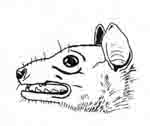 1. Egyptian
fruit bat - Rousettus aegyptiacus
1. Egyptian
fruit bat - Rousettus aegyptiacus
 Identification:
This is one of the largest bats in Saudi Arabia. Total length 134-167
mm; tail
length 9-19 mm; forearm length 84-99 mm and wingspan about 60 cm. The
muzzle is
long, heavy and deep. The ears are somewhat short and not narrowed at
their
bases. The eyes are large. The wing membrane arises from the flanks
thus the
dorsal pelage is not narrowed. The second finger is clawed. The tail
projects
from the ventral surface of the interfemoral membrane to a distance of
about 5-6
mm.
Identification:
This is one of the largest bats in Saudi Arabia. Total length 134-167
mm; tail
length 9-19 mm; forearm length 84-99 mm and wingspan about 60 cm. The
muzzle is
long, heavy and deep. The ears are somewhat short and not narrowed at
their
bases. The eyes are large. The wing membrane arises from the flanks
thus the
dorsal pelage is not narrowed. The second finger is clawed. The tail
projects
from the ventral surface of the interfemoral membrane to a distance of
about 5-6
mm.
Distribution:
Known from Taif, Jeddah, Baha, Raydah and vicinity of Abha. It is most
likely
present all along the western coast of the Kingdom.
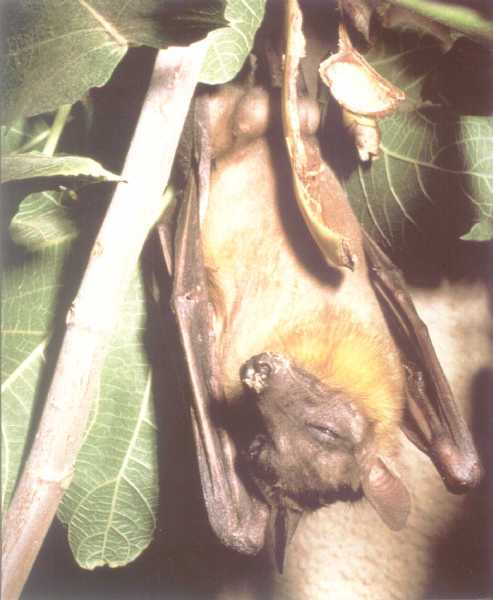
2.
Straw-coloured
fruit bat - Eidolon helvum
Identification:
This is the largest bat recorded in Saudi Arabia. Total length 160-210
mm; tail
length 7-16 mm; forearm length 109-125 mm and wingspan 550-600 mm.
The eyes are
large and the ears are oval-shaped and narrow. The wing membrane arises
high up
on the back so that the dorsal pelage is narrowed as a result of that.
Adult
males have golden hairs on the throat.
Distribution:
Al Baha region and near Sabya south to the Yemen border.
3.
Ethiopian
epaulated fruit bat - Epomophorus labiatus
Identification:
A medium-sized fruit bat. Total length of the single adult female 79 mm
and
forearm length of three adults 65.6-70.2 mm (Gaucher, 1992). Shoulder
pouches
lined with white hairs are well-developed in adult males. Males are
larger than
females.
Distribution:
Recorded only from Raydah escarpment in Asir.
Family
RHINOPOMATIDAE- Mouse
4.
Greater
mouse-tailed bat - Rhinopoma microphyllum
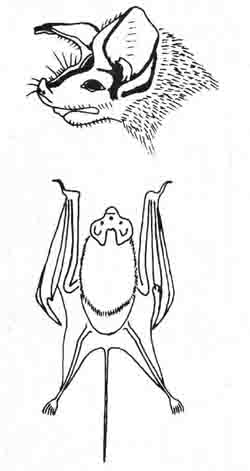
Identification:
This is a large mouse-tailed bat. Total length 132-145 mm; tail length
55-69 mm;
forearm length 60-72 mm. The tail is very long and slender, a large
portion of
it projecting free from the interfemoral membrane. The tail in this
species is
usually shorter than the forearm. The ears are united across the
forehead, and
the tragus is well developed.
Distribution:
It is known from near Madina and the vicinity of Abha
however it is expected to be present all along the Red Sea
coast.
5.
Lesser
mouse-tailed bat - Rhinopoma hardwickii.
Identification:
This is a smaller bat than R. microphyllum,
but otherwise very
similar to it. Total length 110-140 mm; tail length 55-70 m; forearm
length
48-59 mm. The tail is almost always longer than the forearm. Thus, it
is
relatively longer than that of R. microphyllum.
Distribution:
This species is known from several localities in the western region
along the
Red Sea from Midian in the north to the vicinity of Abha and Farasan
island in
the south. It has also been recorded from near Riyadh.
 6.
Naked-bellied
tomb bat - Taphozous nudiventris
6.
Naked-bellied
tomb bat - Taphozous nudiventris
Identification:
This is a large tomb bat. Total length 105-130 mm; tail length 25-33.5
mm;
forearm length 65-79 mm. The posterior parts of both the back and the
abdomen
are void of hair, hence the name of this species. The extremity of the
tragus is
expanded and club-shaped. The tail emerges from the central part of the
interfemoral membrane or slightly further back. The calcar is well
developed.
Distribution:
It is known from near Taif, near Abha and Najran in the southwestern
part of the
Kingdom.
7.
Egyptian tomb
bat - Taphozous perforatus
Identification:
It is a medium-sized sheath-tailed bat similar to T.
nudiventris but
smaller. Total length 81-101 mm; tail length 21-27 mm; forearm length
59-65 mm.
The hair on the dorsal and the ventral sides extend back to the origin
of the
interfemoral membrane. The calcar is less developed than T.
nudiventris.
Distribution:
It is known in the western part of the Kingdom from near Taif, near
Usfan, NE Jeddah;
and near Abha.
Family
NYCTERIDAE - Slit-faced Bats
Identification:
This is a medium-sized slit-faced bat. Total length 97-110 mm; tail
length 47-58
mm; forearm length 42.6-47.0 mm. This bat is easily recognized by the
structure
of its muzzle, which has a deep median furrow, and by the presence of
lateral
projections on the dorsal side of the muzzle. Its ears are large,
measuring
28-34 mm, and their upper edges are rounded. The last tail vertebra is
bifid,
with a T-shaped form. There is a well-developed calcar which supports
the outer
edge of the interfemoral membrane. The pelage is long and dense. Its
colour in
general is light brown above and lighter colour or greyish white on the
ventral
side. Distribution:
It is known from several localities in the western part of the Kingdom.
These
are: Wadi Sawawin; Jeddah and its vicinity; Al Baha; Sabiya; Abha and
vicinity;
Jizan and Najran. Family
RHINOLOPHIDAE - Horseshoe Bats Identification:
This is a medium-sized horseshoe bat. Total length 78-93 mm; tail
length
23.0-35.5 mm; forearm length 45.6 –52.0 mm. The muzzle is covered by a
noseleaf consisting of an erect part called the lancet and a lower
horizontal
horseshoe that covers the upper lip and surrounds the nostrils. There
is also a
perpendicular median outgrowth known as the sella, which has upper and
lower
processes. The upper process of the sella is bluntly pointed in side
view and
its anterior border is slightly concave. The ears are pointed and the
tragus is
absent. The colour of the pelage is light gray-brown-above, and lighter
below. Distribution:
It has been recorded in the western region from Muwailih in the
northwest on the
Red Sea coast; Makka; Taif; Wadi Ad Dawasi; Al Baha; 50 km NNE Abha;
Raydah
escarpment. Identification:
This is a smaller horseshoe bat than R. clivosus,
but otherwise similar
to it. Total length 55-77 mm; tail length 22-33 mm; forearm length
34-38 mm. The
upper process of the sella is low and blunt in side view, while its
lower
process projects out quite clearly. The pelage is dense and soft. The
color is
grayish brown above and lighter below. Distribution:
It has been recorded from Taif and the vicinity of Abha.
11. Lesser
leaf-nosed bat - Hipposideros caffer
Identification:
This is a small leaf-nosed bat with a somewhat long tail. Total length
73-82 mm;
tail length 27-35 mm; forearm 42-47 mm. The nose leaf almost covers the
muzzle.
The fur is soft and long. The colour is variable, ranging from orange
to greyish
brown. Distribution:
In the southwest of Saudi Arabia from Al Jowa; Mothra; Al Baha; Ablah
and Wargan. 12. Small
leaf-nosed bat - Hipposideros megalotis
Identification:
A small, lightly built leaf-nosed bat. Length of head and body 35.2 mm;
forearm
length 35 mm. The ears are large, rounded and united at the base. The
nose leaf
is simple. The colour of the pelage is pale grey above, whitish below. Distribution:
This an African bat. In Saudi Arabia it is recorded only from Jeddah. Identification:
This is also a small leaf-nosed bat. Total length 71-90 mm; tail length
19-26
mm; forearm length 44-54 mm. The nose leaf has three vertical
projections at its
superior edge. The central projection is pointed, while the outer ones
are
blunt. The tip of the ear is bluntly pointed and directed outward. Its
anterior
margin is strongly convex. The tail is well-developed and its tip
projects out
from the interfemoral membrane for about 3-5 mm. Distribution:
The Trident nose-leaf bat is known from near Usfan, about 80 km NW of
Mecca;
Jeddah and its vicinity; near Taif; Durma and Hufuf. 14. Small
trident leaf-nosed bat - Asellia patrizii Identification:
A
small-sized trident leaf-nosed bat. Very much like A. tridens
but smaller.
Forearm length 37.5-39.4 mm. Distribution:
A rare African bat known from several localities in Ethiopia and
Eritrea. In Saudi Arabia,
it has been recorded only from Farasan islands. Family
MOLOSSIDAE - Free-tailed Bats 15.
European free-tailed
bat - Tadarida
teniotis Distribution:
In Saudi Arabia it is known from two localities in the western region:
Wadi
Sawawin and Taif. 16.
Egyptian free-tailed bat - Tadarida aegyptiaca Identification:
A medium-sized free-tailed bat. Smaller than T. teniotis. Total
length
100-121 mm; tail length 34-55 mm; forearm length 48-54 mm. The tragus
is small.
The pelage is fine and dense. The colour is light greyish brown
dorsally. Distribution:
In Saudi Arabia it is known from two localities in the Al Baha region. Identification:
This is a small free-tailed bat. Total length 77-85 mm; tail length
25-30 mm;
forearm length 36-38 mm. The tail is well-developed and about half of
it
projects beyond the interfermoral membrane which is short. The calcar
is
developed. The tragus is small, but the antitragus is large. The upper
lip has
about three vertical ridges on its anterior part. The wings are long
and narrow.
A connecting membrane joins the ears across the forehead. The outline
of the ear
is triangular. Adult males have a frontal crest of hair behind the
ears. The
toes have long hairs. Distribution:
It has been recorded from Jizan and Sabiya in the southwestern part of
the
Kingdom. 18. Nigerian
free-tailed bat - Tadarida nigeriae Identification:
A medium-sized free-tailed bat. Measurements of the two subadult
specimens are:
Total length 95,100 mm; tail length 35,36 mm; forearm length 43,46 mm
(of adult
African specimens are 47-51 mm). The upper lip has seven ridges with
short stiff
spines. The relatively small ears are almost ovoid in shape and are
connected
across the forehead by a membrane. Distribution:
In Saudi Arabia it is known from Abha and Raydah escarpment. Identification: This is a
larger free-tailed bat than T.
pumila. Total length 125-138 mm; tail length 41-51mm; forearm
length
57.7-60.0 mm. External features are similar to T. pumila;
however it is
clearly heavier built, with larger feet and tail. There are seven
vertical
ridges on the anterior part of the upper lip. The calcar is strong. The
ears are
large, oval-shaped and joined by a connecting membrane across the
forehead. Distribution:
It has been recorded only from south of Al Mowassam, near the Yemen
border and
Al Jowa. Family
VESPERTI LIONIDAE - Vespertilionid Bats 20. Notch-eared
bat - Myotis emarginatus Identification:
A small, lightly built bat. Total length 87-93 mm; tail length 38-44
mm; forearm
length 40-44 mm. The tail is well developed, only its extreme tip
projects from
the interfemoral membrane. The pelage is dense and woolly. The colour
is
distinctive. The hairs on the back are tricoloured. The basal third is
slate
grey, the middle third is buff and the tips darker, mostly orange
brown. The
ventral surface is paler. The wing membrane blackish. Distribution:
In Saudi Arabia it is known from near Taif and Raydah escarpment. 21. Botta’s
serotine bat - Eptesicus bottae Identification:
A medium sized serotine bat. Total length 90-97 mm; tail length 39-42
mm;
forearm length 40-42 mm. The tip of the tail extends about 3.5 mm from
the
interfemoral membrane. The pelage is soft, dense and usually long. The
tips of
the hairs are pale buffy clay colour. The lower surface is white. Distribution:
A rare bat in Saudi Arabia. It is known only from Misfera, about 40 km
north of
Abha. 22. Sind
serotine bat - Eptesicus nasutus
Identification:
This is a small serotine bat. Total length 80.5-91.0 mm; tail length
38.0-38.5
mm; forearm length 33.0-38.5 mm. The muzzle is simple. The tail is
well-
developed and it is completely enclosed in the interfemoral membrane
except for
its extreme tip which projects out of the membrane. The ear is small
and its
anterior edge has a well-developed angular basal lobe. The tragus is
well-developed also. The colour of the limbs and ears are blackish
contrasting
with the uniform pale buffy colour of the pelage. Distribution:
It has been recorded from near Jeddah; Al Jow in the southwest; Al
Aflaj and
Dhahran. It is expected that this species has a wider range in the
Kingdom. 23. Kuhl’s
pipistrelle - Pipistrellus kuhlii
Identification:
This is a small vespertilionid bat. Total length 70-93 mm; tail length
32-42 mm;
forearm length 30-36 mm. This bat is similar in external features to Eptesicus
nasutus however there are some cranial differences especially
in the dental
formula. This bat has two upper premolars while E. nasutus
has only one.
The colour of the pelage is brownish to blackish above and light brown
or
whitish below. The wing membrane always has a distinct white border
between the
foot and the fifth digit, tending to invade the membrane which is
paler-coloured
and has translucent striation. Distribution:
In Saudi Arabia it is known from near Taif; Raydah escarpment; near
Marrat in
central Najd; Riyadh and Hufuf. 24.
Bodenheimer’s pipistrelle - Pipistrellus
bodenheimeri Distribution:
It has been recorded only from near Taif. 25.
Schlieffen’s bat - Nycticeinops schlieffeni Identification:
This is also a small vespertilionid bat. Total length 69-79 mm; tail
length
28.5-33 mm; forearm length 29.6-32.7 mm. It is quite similar externally
to E.
nasutus, however there are some cranial differences
especially in the dental
formula. This species has one upper incisor while E. nasutus
has two. The
ears are short and somewhat broad. The calcar is long, supporting about
half of
the free edge of the interfemoral membrane. The pelage colour is
variable
ranging from reddish brown to geyish. The ventral side is paler. Distribution:
It has been recorded from near Qunfida and from 20 miles SE of Qunfida
in the
western part of the Kingdom. 26. Lesser
yellow house bat - Scotophilus leucogaster Identification:
A moderately robust vespertilionid bat. Total length 102-118 mm; tail
length
41-49 mm; forearm length 51-53 mm. The tail is well developed and it
projects 3
mm from the interfemoral membrane. The wing membranes are attached to
the bases
of the outer toes. The colour of the dorsal side is mostly olive brown
and that
of the ventral side is paler. The lower throat is buffy yellow. Distribution:
In Saudi Arabia it is recorded only from Abha-Raydah escarpment. 27. Hemprich’s
long-eared bat - Otonycteris hemprichi Identification:
This is a large vespertilionid bat. Total length 122-188 mm; tail
length 55-58
mm; forearm length 62.6-66.0 mm. This bat is easily distinguished by
its long
ears, which are about two third as long as the forearm. The ear tip is
bluntly
rounded off. The antitragus is very small, while the tragus is very
large. The
tail is well- developed and its tip projects from the interfemoral
membrane for
about 4-5 mm. The pelage is dense and long. Its colour is very pallid
dorsally
and it is white ventrally in the adults. Distribution:
In Saudi Arabia it is has been recorded from Hail; Unaiza; Taif; Riyadh
and
Hufuf. 28. Grey
long-eared bat - Plecotus austriacus Identification:
A small vespertilionid bat with large ears. Measurements of two
specimens from
Saudi Arabia are: total length 85 mm; tail length 35-37 mm; forearm
length 40
mm. The tail is relatively long. The tragus is large. The wing
membranes are
inserted on the bases of the outer toes. The calcar is well-developed.
The
pelage is long and dense and the colour of the dorsal side is greyish
and the
ventral side is white. Distribution:
In Saudi Arabia it is known only from Misfera, north of Abha. 29.
Schreiber’s long-winged bat - Miniopterus schreibersii Distribution:
In Saudi Arabia it has been recorded from near Taif; Abha; Abha-Raydah
escarpment and Ablah. BIBLIOGRAPHY
This
bibliography includes all known published literature on the bats of
Saudi
Arabia. Abu
Yaman, I. K. 1966. Insect pests of Saudi
Arabia. Z. angew. Entomol., 58:266-278. Ayyoub,
M. S. 1960. Insects and crop pests and their control in
Saudi Arabia;
Ministry of Agr.,
Riyadh, Saudi
Arabia, 405 pp. (in Arabic). Cheesman
D.R.E. and M. A. C. Hinton. 1924. On
the mammals collected in the desert of Central Arabia by Major R. E.
Cheesman.
Ann. Mag. Nat. Hist. 9th Ser. 14:548-558. Ellerman,
J. R. and T. C. S.
Morrison-Scott. 1951. Checklist of Palaearctic and
Indian Mammals, 1758 to 1946: British Museum (Nat. History.), London
810 pp. Gaucher,
P. 1992. New record of an epaulated
bat Epomophorus labiatus Temminck, 1837 (Mammalia:
Chiroptera;
Pteropodidae) in Saudi Arabia. Mammalia, Vol. 56, No. 4: 657-559. Gaucher,
P. 1993. First record of Scotophilus
leucogaster (Cretzschmar, 1826) (Mammalia: Chiroptera:
Vespertilionidae) in
Saudi Arabia. Mammalia, Vol. 57, No. 1:146-147. Gaucher,
P. and A. Brosset. 1990. Record of Hipposideros
(Synesmotis) megalotis Heuglin) in Saudi Arabia. Mammalia,
Vol. 54, No. 4:
653-654. Gaucher,
P. and D. L. Harrison. 1995.
Occurrence of Bodenheimer’s pipistrelle Pipistrellus
bodenheimeri Harrison,
1960 (Mammalia: Chiroptera: Vespertilionidae) in Saudi Arabia.
Mammalia, Vol.
59, No. 4: 672-673. Harrison,
D.L. 1956. A key to the
identification of bats (Chiroptera) of the Arabian Peninsula:
Proc. Zool. Soc. Lond., 127, Part 4: 447 A52. Harrison,
D. L. 1957, Some systematic notes on
the Trident bats (Asellia tridens E. Geoffroy) of
Arabia: Mammalia, Vol.
21, No.1:1-8. Harrison,
D. L. 1964. The Mammals of Arabia.
Vol.1. Insectivora. Chiroptera. Primates: Emest Benn Ltd.,
London, xx+192 pp. Harrison,
D. L. 1972. The Mammals of Arabia.
Vol. 3. Lagomorpha. Rodentia: Ernest Benn Ltd., London, P. 383-670
(App.
IV:626-629). Harrison,
D. L. and P. J. J. Bates. 1991. The
Mammals of Arabia. 2nd ed. Harrison Zoological
Museum Publication.
354 pp. Hayman,
R.W. 1954. Notes on some African Bats,
mainly from the Belgian Congo. Revue
Zool.
Bot. Afr., 50: 277-295. Hayman,
R.W. and D. L. Harrison. 1950. Notes
on some mammals newly recorded from Arabia. Ann, Mag. Nat. Hist. (Ser
12), Vol.
3:417-419. Moeschler,
P., I. A. Nader and P. Gaucher.
1990. First record of Asellia patrizii De Beaux,
1931 (Chiroptera:
Hipposideridae) in Saudi Arabia. Mammalia, Vol. 54, No. 4: 654-655. Kock,
D. and I. A. Nader. 1984. Tadarida
teniotis (Rafinesque, 1814) in the W-Palaearctic and a
lectotype for
Dysopes rupellii Temminck, 1826 (Chiroptera: Molossidae).
Z.F.
Saugetierkunde, Vol. 49, No. 3: 129-135. Morrison-Scott,
T. C. S. 1939, Some Arabian
mammals collected by Mr. H. St. J.B. Philby: C.I.E. Novit. Zool.,
41:181-211. Nader, I. A. 1973. In
Quest of bats. Jour. Saudi Arabian Nat. Hist. Soc., No. 10: 5-7. Nader,
I. A. 1975. On the bats (Chiropetra) of
the Kingdom of Saudi Arabia. Jour. Zool., Lond., Vol.176: 331-340. Nader, I. A. 1976. Bats
of the Kingdom of Saudi Arabia. Jour. Saudi Arabian Nat. Hist. Soc.,
No. 17:
4-12. Nader, I. A. 1978.
Zoogeographical notes on the bat fauna of Saudi Arabia. 4th.
Int. Bat
Res.Conf., : 173-176; Nairobi. Nader, I. A. 1982. New
distributional records of bats from the Kingdom of Saudi Arabia
(Mammalia:
Chiroptera). Jour. Zool., Lond., Vol. 198: 69-82. Nader, I. A. and D. Kock.
1980. First record of Tadarida nigeriae (Thomas
1913) from the Arabian
Peninsula. Senckenbergiana biol., Vol. 60, No. 3/4: 131-135. Nader, I. A. and D. Kock.
1983. Notes on some bats from the Near East (Mammalia: Chiroptera). Z.
Saugetierkde, Vol. 48, No. 1: 1-9. Nader, I. A. and D. Kock.
1983. A new slit-faced bat from central Saudi Arabia (Mammalia:
Chiroptera:
Nycteridae). Senckenbergiana biol., Vol. 63, No. 4/6: 9-15. Nader, I. A. and D. Kock.
1983. Rhinopoma microphyllum asirensis n. subsp.
from southwestern Saudi
Arabia. (Mammalia: Chiroptera: Rhinopomatidae). Senckenbergiana biol.,
Vol. 63,
No. 3/4: 147-152. Nader, I. A. and D. Kock.
1986. First record of Miniopterus schreibersi (Kuhl
1819) (Mammalia:
Chiroptera) from North Yemen with zoogeographical relationship
evidenced by wing
mites (Acarina: Spinturnicidae). Senckenbergiana biol., Vol. 67, No.
4/6:
225-229. Nader, I. A. and D. Kock.
1990. Eptesicus (Eptesicus) bottae (Peters 1869)
in Saudi Arabia with
notes on its subspecies and distribution (Mammalia: Chiroptera:
Vespertilionidae).
Senckenbergiana biol., Vol. 70, No. 1/3: 1-13. Nader, I. A. and D. Kock.
1990. Plecotus austriacus (Fischer, 1829) new to
Saudi Arabia, with
remarks on taxonomy and zoogeography (Mammalia: Chiroptera:
Vespertilionidae).
Fauna of Saudi Arabia, Vol. 11: 318-322. OF THE BATS (ORDER CHIROPTERA)
OF
* new to
the list since 1976 MEGACHIROPTERA (suborder) Pteropodidae
(family)
1. Rousettus
aegyptiacus Egyptian
fruit bat
*
2.
Eidolon helvem Straw-coloured
fruit bat
3.
Epomophorus labiatus
Ethiopian epaulated fruit bat MICROCHIROPTERA
(suborder) Rhinopomatidae
(family)
4.
Rhinopoma microphylum
Greater mouse-tailed bat*
5.
Rhinopoma hardwickei Lesser
mouse-tailed bat* Emballonuridae
(family)
6.
Taphozous nudiventris
Naked-bellied
tomb bat*
7.
Taphozous perforatus Egyptian
tomb bat* Nycteridae
(family)
8.
Nycteris thebaica Aden
slit-faced bat * Rhinolophidae
(family)
9.
Rhinolophus
clivosus Geoffroy’s
horseshoe bat*
10. Rhinolophus hipposideros Lesser
horseshoe bat* Hipposideridae
(family)
11. Hipposideros caffer Lesser
leaf-nosed bat
12. Hipposideros megalotis
Small leaf-nosed bat
13. Asellia tridens Trident
leaf-nosed bat *
14. Asellia patrizii Small
trident leaf-nosed bat Molossidae
(family)
15. Tadarida teniotis European
free-tailed bat
16. Tadarida aegyptiaca Egyptian
free-tailed bat
17. Tadarida pumila Lesser
free-tailed bat *
18. Tadarida nigeriae Nigerian
free-tailed bat
19. Tadarida midas
Midas
free-tailed bat * Vespertilionidae
(family)
20. Myotis emarginatus Notch-eared
bat
21. Eptesicus bottae Botta’s
serotin bat
22. Eptesicus nasutus Sind
serotine bat *
23. Pipistrellus kuhli
Kuhl’s
pipistrelle *
24. Pipistrellus bodenheimeri Bodenheimer’s
pipistrille
25. Nycticeinops schlieffeni Schlieffen’s
bat *
26. Scotophilus leucogaster Lesser
yellow house bat
27. Otonycteris hemprichi Hemprich’s
long-eared bat *
28. Plecotus austriacus Grey
long-eared bat
29. Minopterus schreibersi Schreib 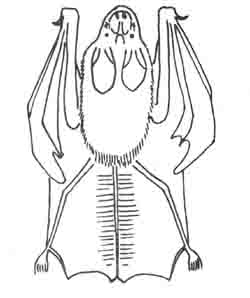
 9. Geoffroy’s
horseshoe bat - Rhinolophus clivosus
9. Geoffroy’s
horseshoe bat - Rhinolophus clivosus
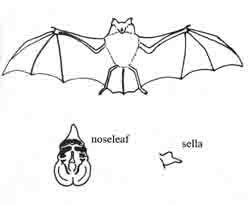 10.
Lesser
horseshoe bat - Rhinolophus hipposideros
10.
Lesser
horseshoe bat - Rhinolophus hipposideros
Family HIPPOSIDERIDAE -
Leaf-nosed Bats
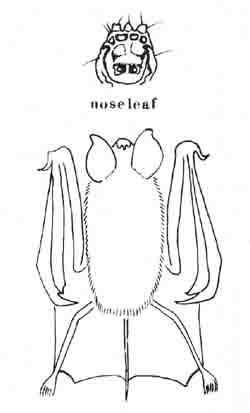 13. Trident
leaf-nosed bat - Asellia tridens
13. Trident
leaf-nosed bat - Asellia tridens 
Identification:
A large free-tailed bat. The body is well built,
the ears are large and
the wings are long and narrow. Total length 123-140 mm; tail length
43-55 mm;
forearm 58-64 mm and wingspan 400-450 mm. The upper lips have a series
of
vertical furrows. The tips of the ears are rounded and not joined at
their
anterior bases. The outline of the tragus is square and the antitragus
is large.
The toes are densely covered with short stiff hairs. The pelage is soft
and
dense and the colour is dark grey.
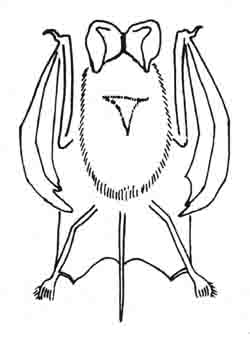 17.
Lesser
free-tailed bat - Tadarida pumila
17.
Lesser
free-tailed bat - Tadarida pumila
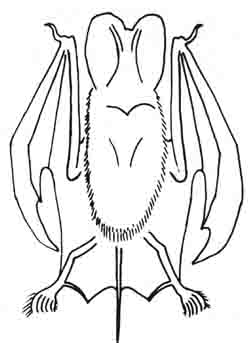 19.
Midas
free-tailed bat - Tadarida midas
19.
Midas
free-tailed bat - Tadarida midas
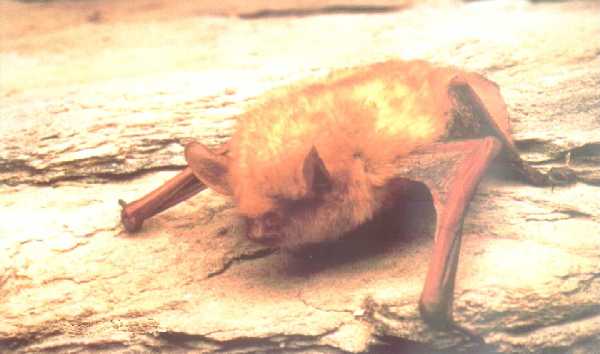
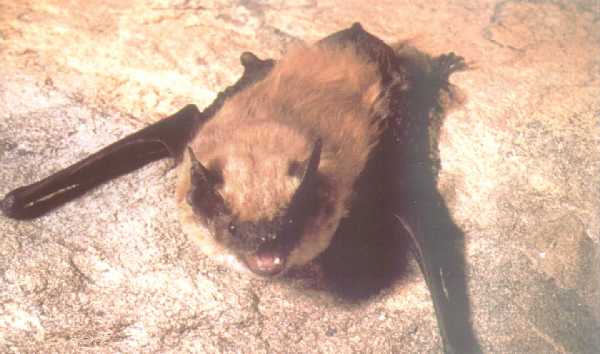
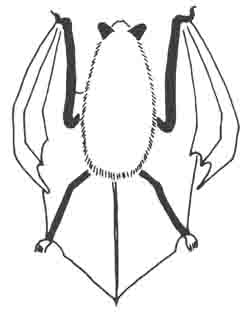
Identification:
It is one of the smallest pipistrelles of the peninsula. Total length
70-72 mm;
tail length 32-35 mm; forearm length 30-30.5 mm. The tail is relatively
long.
The tip of the tail slightly extends from the interfemoral membrane.
The
interfemoral membrane is pale, translucent and contrast with the dusky
blakish
wing membrane. The pelage is long, dense and grey-coloured dorsally and
paler
ventrally.
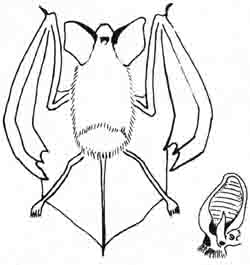
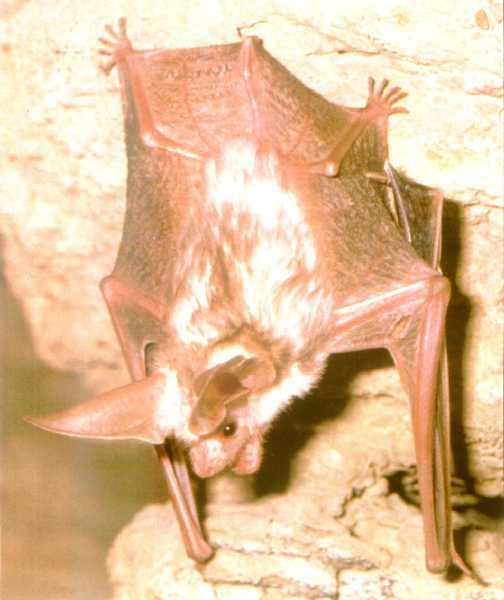
Identification:
A medium sized bat with relatively long legs and tail. Total length
105-106 mm;
tail length 50-51 mm; forearm length 44.0-44.4 mm. The wings are dark
and
moderately wide at the base, narrow and elongated at the distal end.
The
interfemoral membrane is pale brown and semi translucent. The colour of
the head
and neck is blackish and the dorsal side is dark brown.